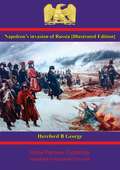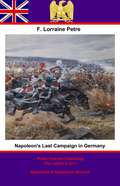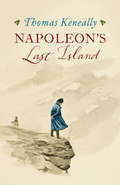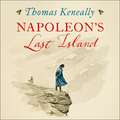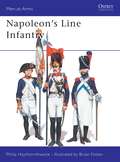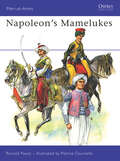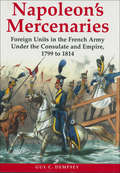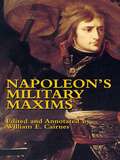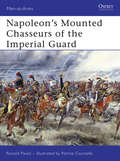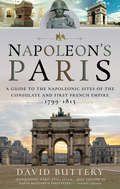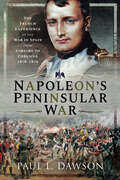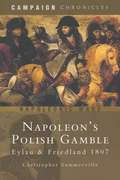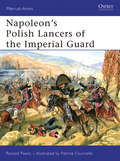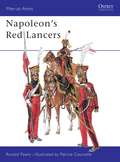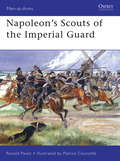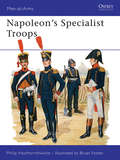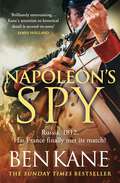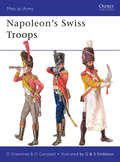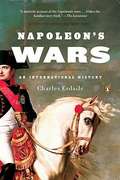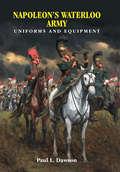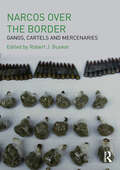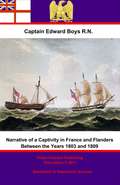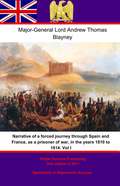- Table View
- List View
Napoleon's invasion of Russia [Illustrated Edition]
by Hereford B. GeorgeNapoleon's invasion of Russia remains the benchmark for military disaster, even some two hundred year after he and his 600,000 men crossed the Niemen into the interior of Russia. The story of these men and their stolid, valiant opponents, the Russians, is recounted in admirable detail by the Author: from the killing fields of Smolensk and Borodino to the great fire of Moscow and the retreat through the snows of the Russian winter. Illustrated with 8 plans, the action of the great struggle is brought into full life, even through the passage of so much time.Author -- George, Hereford B. 1838-1910.Text taken, whole and complete, from the edition published in London, T.F. Unwin, 1899.Original Page Count - xv, 451 p.Illustrations -- 8 maps and plans.
Napoleon's Last Campaign in Germany
by Pickle Partners Publishing Francis Loraine Petre O.B.EThis ebook is purpose built and is proof-read and re-type set from the original to provide an outstanding experience of reflowing text for an ebook reader. Having escaped the disaster of the Russian campaign of 1812, Napoleon set out to defeat a coalition of epic proportions, who had coalesced to change the French preponderance of power on the Continent. Leaving his stepson Eugène with the shattered remnants of the Grande Armée in northern Germany, Napoleon's great organisation skills would be used to the full to replace his depleted ranks. Short of cavalry, to scout and follow up any victory and with in-experienced troops, Napoleon struck at the Allied armies with vigour and energy, not wholly seconded by his subordinates. The battles of Lützen and Bautzen proved that he had the will and drive to beat his opponents, but time was running out. As losses mounted, including Grand Marshal of the Palace Duroc and Marshal Bessières, Napoleon could not hope to be everywhere at once. Oudinot was beaten at Gross-Beeren, Vandamme was destroyed at Kulm, Macdonald defeated on the Katzbach and Ney at Dennewitz, the hopes of the French were also brutally dashed by the Austrians joining the ranks of their enemies. The dénouement would be the largest battle known to man at that point in history, fought over three days the battle of Leipzig was rightly known as the "Battle of Nations", two thousand cannon and nearly six hundred thousand men would pound, charge, fire, and die to change the face of Europe. Continuing on in the series of books, after Napoleon and the Archduke Charles, Petre's monumental summation of the 1813 campaigns in Germany is still relevant fresh and excellently researched, balanced. Author - Francis Lorraine Petre OBE - (1852-1925) Text taken, whole and complete, from the edition published in 1902, London, by John Lane, The Bodley Head. Original - 441 pages. MAPS - due to their size have not been included [4 A3]
Napoleon's Last Island
by Thomas KeneallyOn the island of St Helena in the south Atlantic ocean, Napoleon spends his last years in exile. It is a hotbed of gossip and secret liaisons, where a blind eye is turned to relations between colonials and slaves.The disgraced emperor is subjected to vicious and petty treatment by his captors, but he forges an unexpected ally: a rebellious British girl, Betsy, who lives on the island with her family and becomes his unlikely friend.Based on fact, Napoleon's Last Island is the surprising story of one of history's most enigmatic figures and a British family who dared to associate with him. It is a tale of vengeance, duplicity and loyalty, and of a man whose charisma made him dangerous to the end.
Napoleon's Last Island
by Thomas KeneallyOn the island of St Helena in the south Atlantic ocean, Napoleon spends his last years in exile. It is a hotbed of gossip and secret liaisons, where a blind eye is turned to relations between colonials and slaves.The disgraced emperor is subjected to vicious and petty treatment by his captors, but he forges an unexpected ally: a rebellious British girl, Betsy, who lives on the island with her family and becomes his unlikely friend.Based on fact, Napoleon's Last Island is the surprising story of one of history's most enigmatic figures and a British family who dared to associate with him. It is a tale of vengeance, duplicity and loyalty, and of a man whose charisma made him dangerous to the end.
Napoleon's Light Infantry
by Philip Haythornthwaite Bryan FostenAlthough light infantry tactics formed one of the cornerstones of the Napoleonic Wars (1799-1815), their employment was by no means restricted to Light regiments. Thus, from the early 1800s, if not before, the distinction between Light and Line infantry was largely one of costume and tradition. One marked difference from the Line infantry, however, was in the superior ésprit de corps of the Light regiments. Their attitude of superiority was reinforced by their different (and often more impressive) uniform, the theoretical difference in role, and supposed superior training. Philip Haythornwaite examines their uniforms in a volume including eight superb colour plates by Brian Fosten.
Napoleon's Mamelukes
by Ronald Pawly Patrice CourcelleThe most exotic of all the troops of Napoleon's Imperial Guard were undoubtedly the Mamelukes - the bodyguard of Oriental cavalry which followed him home after the Egyptian expedition of 1798-1801, and remained with his Mounted Chasseurs regiment throughout the First Empire. For the first time in English, this book tells the Mamelukes' story, from Austerlitz (1805) to Waterloo (1815). Quoting from the original nominal rolls and battle casualty returns, the author brings individual members of this extraordinary unit to life. His text is illustrated with rare early engravings and paintings, and the full-colour plates show the development of the unit's romantic Turkish uniforms.
Napoleon's Mercenaries: Foreign Units in the French Army Under the Consulate and Empire, 1799 to 1814 (Napoleonic Library)
by Guy DempseyThis superb and comprehensive book details the foreign units which formed such an important part of Napoleon's forces. It examines each non-French unit in turn, giving an overview of the unit's origins, its organizational and combat history, its uniforms and standards, and details of the unit's eventual fate. Colourful accounts, taken from contemporary reports and memoirs, emphasize the qualities of the unit and throw light on what life was like for many of the foreign soldiers recruited into the Grande Armée. In total more than 100 different foreign units that served in the French Army are investigated in detail in this ambitious publication. Some foreign units fought and flourished throughout the Consulate and Empire, whilst others lasted for just a few months. Covers Polish, German, Swiss, Italian, Spanish, and other units in the French Army and presents a combat history and details uniforms for each regiment. Napoleon's Mercenaries is the best single-volume study of this aspect of Napoleon s army and a vital reference for every Napoleonic enthusiast. Little can be found on the foreign units that were an integral part of the French army ... For a long time a gap has existed, but now Napoleon s Mercenaries fills this gap. Robert Burnham, Napoleonic Series
Napoleon's Military Maxims
by George C. D'Aguilar William E. Cairnes Napoleon BonaparteThis classic brings together a rich sampling of the knowledge and wisdom of one of history's greatest military commanders. The concise text not only provides a fascinating glimpse of the French leader's intellectual ability for conducting military operations but also reveals his thoughts, theories, and commentaries on waging war and the art of conducting statecraft. Equally relevant to today's entrepreneur, the book is packed with maneuvers that can be applied just as easily to increasing revenues on the battlefield of commerce.
Napoleon's Mounted Chasseurs of the Imperial Guard
by Ronald Pawly Patrice CourcelleA concise history of the hand-picked elite cavalry guard that served as Napoleon's close personal escort and were committed to the most dangerous areas of combat on the battlefield. Formed from his original escort of "Guides" and the "Consular Guard" in 1799, the Mounted Chasseurs were a personal favourite of the Emperor, who wore their uniform on campaign. Ronald Pawly's unique research into regimental archives has uncovered unprecedented detail about this exceptional unit and its soldiers and officers. With their colorful uniforms recreated in full-color artwork and accounts of their actions in the most critical battles of the Napoleonic Wars (1799-1815), this book provides a comprehensive description of a legendary elite.
Napoleon's Paris: A Guide to the Napoleonic Sites of the Consulate and First French Empire 1799–1815
by David ButteryA specialist in Napoleonic history reveals the legendary leader’s influence on the City of Light in this illustrated visitor’s guide.Historian David Buttery explores the many connections between Napoleon and Paris, where many remarkable buildings and monuments date from his time in power. Many of the city’s most famous sites were built or enhanced on Napoleon’s instructions, while others are closely associated with him and the First French Empire.Buttery explores the Napoleonic history of the Arc de Triomphe, the Louvre, the Hôtel des Invalides, Musée de l’Armée, Notre Dame Cathedral, Père-Lachaise Cemetery, and other fascinating sites. Full of evocative detail and practical information, Napoleon’s Paris is essential reading for every history buff who visits the French capital.
Napoleon's Peninsular War: The French Experience of the War in Spain from Vimeiro to Corunna, 1808–1809
by Paul L DawsonA renowned historian captures the French experience of the Peninsular War through soldiers’ unpublished memoirs and eyewitness accounts.While much has been written about the British campaigns of the Peninsular War, surprisingly little has been published in English on their opponents, the French. Now, using previously unseen material from the French army archives in Paris, Paul Dawson tells the story of the early years of the Peninsular War as never before.Eyewitness accounts of the Siege of Zaragoza and the Spanish defeats at Medellin and Ocaña are interspersed with details of campaign life and of struggling through the Galician mountains in pursuit of the British army. Dawson captures the perspectives of ordinary French soldiers and their beliefs about the war they were fighting for their Emperor. Napoleon’s Peninsular War is a vital and unprecedented addition to our understanding of the war in Iberia.
Napoleon's Polish Gamble: Eylau & Friedland 1807: Campaign Chronicles (Campaign Chronicles Ser.)
by Christopher SummervilleNapoleon's 1807 campaign against the Russians came close to being his first defeat. At Eylau the Emperor was outnumbered by the army of the Russian commander Bennigsen, yet he accepted battle. His reputation was saved by the flamboyant Murat, who led one of the greatest cavalry charges in history. Christopher Summerville's gripping account of this bitterly fought clash and of Napoleon's subsequent triumph at Friedland is the first extensive study of the campaign to be published for a century. The story is told in the concise, clear Campaign Chronicles format which records the action in vivid detail, day by day, hour by hour. Included are full orders of battle showing the chain of command and the fighting capabilities of the opposing armies.
Napoleon's Polish Lancers of the Imperial Guard
by Patrice Courcelle Ronald PawlyNapoleon's Polish Lancers of the Guard were unique in their appearance and in their loyalty. This book reveals their varied and colorful uniforms as well as their long and loyal service for the Bonaparte cause during the Napoleonic Wars (1799-1815). The Poles were the only foreign contingent never to defect from Napoleon's cause, staying faithful to the end - a squadron even accompanied Napoleon into exile on Elba, and the Guard reformed in 1815 to charge at Waterloo. In 1808, when Napoleon was smashing his way through the Spanish armies to get at British forces in the Peninsular, the Poles astounded observers with their extreme acts of courage and military daring. In one memorable instance the Poles captured a defended mountain pass at Somosierra, overrunning four batteries of cannons in the process. It was they who introduced the use of the lance to the French army, adding a new tactical dimension to the use of the cavalry on the battlefield and demonstrated its deadly effects in all of Napoleon's most famous victories - particularly Wagram in 1809. Brave and ruthless in equal measures, this is a fascinating insight into the fighting lives of the legendary Polish Lancers.
Napoleon's Red Lancers
by Ronald Pawly Patrice CourcelleThe legendary Dutch 'Red' Lancers - the 2nd Light Horse Lancers of Napoleon's Imperial Guard - were formed in 1810, during the Napoleonic Wars (1799-1815), after the emperor annexed Holland and its army to France. The former hussars of the Dutch Royal Guard got a handsome new uniform, a new weapon, and a hard-driving new colonel in Baron Edouard Colbert. His lancers distinguished themselves in Russia in 1812, at huge cost; in Germany in 1813, and in the Low Countries in 1814. When Napoleon returned from exile in 1815 the Red Lancers were with him until night fell over Waterloo. Ronald Pawly is the world's leading expert on the archival and pictorial record left by this regiment; his detailed text is illustrated with rare portraits and photographs, and eight glowing colour plates of a surprisingly wide variety of uniforms.
Napoleon's Scouts of the Imperial Guard
by Patrice Courcelle Ronald PawlyDriven out of Germany after his defeat at Leipzig in 1813, Napoleon seemed to face disaster. Some 345,000 Allied troops were converging on France from the east; and Napoleon had only about 80,000 men. Most of his veterans had been killed in Russia and Germany, and he was short of cavalry to counter the swarms of Cossacks. For his last and possibly most brilliant campaign, Napoleon raised three regiments of mounted Scouts for his Imperial Guard. Through the story of these units the reader can follow Napoleon's dazzling manoeuvres in the campaign of 1814; and their widely varied uniforms are reconstructed in meticulously researched colour plates.
Napoleon's Specialist Troops
by Philip Haythornthwaite Bryan FostenThough less celebrated than the infantry and cavalry, Napoleon's 'specialist' troops - artillery, engineers and supporting services - were indispensable elements without which no army could have operated, and frequently assumed greater significance than the line regiments. Indeed, having suffered least from the emigration of Royalist officers, the artillery was the best element of the early Republican armies, the nucleus of the old Royal artillery serving with distinction in the early campaigns such as Valmy. The organisation and uniform of Napoleon's specialist troops are here examined by Philip Haythornwaite in a engaging volume complemented by a wealth of illustrations including eight full page colour plates by Bryan Fosten.
Napoleon's Spy: The brand new epic historical adventure from Sunday Times bestseller Ben Kane
by Ben Kane'Napoleon's Spy is a tour de force on an epic scale' Douglas Jackson 'Exciting, immersive, well researched and great fun.' Giles KristianRussia, 1812. Has France finally met its match?On the eve of the invasion of Russia, half-French, half-English Matthieu Carrey finds himself in the ranks of Napoleon's five hundred thousand strong army. With Tsar Alexander seemingly ill-prepared, a French victory seems certain. The Grande Armée will obliterate everything in its path. Carrey's purpose is less clear. Blackmailed into becoming a spy in the emperor's army, he hopes to follow his lover, a French actress who has gone to work in the Moscow theatre. As supplies grow scarce and temperatures plummet, the Grande Armée begins to crumble. Caught up in the maelstrom of war, Carrey embarks on an epic journey, while the Russians circle like hungry wolves. Hundreds of miles lie between Carrey and safety. To reach it seems utterly impossible.
Napoleon's Spy: The brand new epic historical adventure from Sunday Times bestseller Ben Kane
by Ben Kane'Napoleon's Spy is a tour de force on an epic scale' Douglas Jackson 'Exciting, immersive, well researched and great fun.' Giles KristianRussia, 1812. Has France finally met its match?On the eve of the invasion of Russia, half-French, half-English Matthieu Carrey finds himself in the ranks of Napoleon's five hundred thousand strong army. With Tsar Alexander seemingly ill-prepared, a French victory seems certain. The Grande Armée will obliterate everything in its path. Carrey's purpose is less clear. Blackmailed into becoming a spy in the emperor's army, he hopes to follow his lover, a French actress who has gone to work in the Moscow theatre. As supplies grow scarce and temperatures plummet, the Grande Armée begins to crumble. Caught up in the maelstrom of war, Carrey embarks on an epic journey, while the Russians circle like hungry wolves. Hundreds of miles lie between Carrey and safety. To reach it seems utterly impossible.
Napoleon's Swiss Troops
by David Greentree Gerry EmbletonEver since the 15th century Switzerland had been exporting professional soldiers to serve as mercenaries for foreign monarchies. Napoleon, therefore, was not the first to make full use of the martial qualities of the Swiss and obtained Swiss agreement to expand the recruitment of regiments for service in the French Army. Napoleon would use Swiss troops on the battlefields of Italy and Spain, and in 1812 re-organize the four original regiments into a single division for the invasion of Russia, with each regiment having three full-strength battalions. In all theatres where they were engaged, Swiss contingents would often be relied upon to act as rearguards so other forces caught in a tight situation could escape. Time and again they would be asked to save the day for the French soldiers with whom they fought, in Italy and Spain and most famously for Napoleon himself, in Russia. In November of 1812, meeting up with Napoleon's main force retreating from Moscow at the Berezina River, the Swiss on the west bank guarded the approaches to the pontoon bridges from the Russian attack to the south. 1,200 Swiss, out of approximately 8,000 that entered Russia, were left to face, along with 8,000 men from other units, the 30,000-strong Russian army. The Swiss held their ground and when their ammunition ran out they charged the Russians with bayonets. This book reveals the proud combat history of the Swiss troops of Napoleon's army as well as the colourful uniforms they wore.
Napoleon's Wars: An International History
by Charles EsdaileA glorious?and conclusive?chronicle of the wars waged by one of the most polarizing figures in military historyAcclaimed on both sides of the Atlantic as a new standard on the subject, this sweeping, boldly written history of the Napoleonic era reveals its central protagonist as a man driven by an insatiable desire for fame, and determined ?to push matters to extremes.? More than a myth-busting portrait of Napoleon, however, it offers a panoramic view of the armed conflicts that spread so quickly out of revolutionary France to countries as remote as Sweden and Egypt. As it expertly moves through conflicts from Russia to Spain, Napoleon?s Wars proves to be history writing equal to its subject?grand and ambitious?that will reframe the way this tumultuous era is understood.
Napoleon's Waterloo Army: Uniforms and Equipment
by Paul L. DawsonThe author of Waterloo: The Truth at Last &“sheds new light on the campaign of 1815 and surely will satisfy all with an interest in the Napoleonic Era&” (The Napoleonic Historical Society Newsletter). When Napoleon returned to Paris after exile on the Island of Elba, he appealed to the European heads of state to be allowed to rule France in peace. His appeal was rejected and the Emperor of the French knew he would have to fight to keep his throne. In just eight weeks, Napoleon assembled 128,000 soldiers in the French Army of the North and on 15 June moved into Belgium (then a part of the kingdom of the Netherlands). Before the large Russian and Austrian armies could invade France, Napoleon hoped to defeat two coalition armies, an Anglo-Dutch-Belgian-German force under the Duke of Wellington, and a Prussian army led by Prince von Blücher. He nearly succeeded. Paul Dawson&’s examination of the troops who fought at Ligny, Quatre-Bras and Waterloo, is based on thousands of pages of French archival documents and translations. With hundreds of photographs of original artifacts, supplemented with scores of lavish color illustrations, and dozens of paintings by the renowned military artist Keith Rocco, Napoleon&’s Waterloo Army is the most comprehensive, and extensive, study ever made of the French field army of 1815, and its uniforms, arms and equipment. &“Contains many rare and previously unpublished images in the form of full color drawings and photographs of surviving relics. As with the earlier volumes, this book will appeal to and be enjoyed by a wide readership with special interest for historians, military history enthusiasts, Napoleonic War enthusiasts and re-enactors.&” —Firetrench
Narcos Over the Border: Gangs, Cartels and Mercenaries
by Robert J. BunkerThe book takes a hard hitting look at the drug wars taking place in Mexico between competing gangs, cartels, and mercenary factions; their insurgency against the Mexican state; the narco-violence and terrorism that is increasingly coming over the border into the United States, and its interrelationship with domestic prison and street gangs. Analysis and response strategies are provided by leading writers on 3GEN gang theory, counterterrorism, transnational organized crime, and homeland security.Narcos Over the Border is divided into three sections: narco-opposing force (NARCO OPFOR) organization and technology use; patterns of violence and corruption and the illicit economy; and United States response strategies. The work also includes short introductory essays, a strategic threat overview, an afterword and selected references. Specific topics covered include: advanced weaponry, internet use, kidnappings and assassinations, torture, beheadings, and occultism, cartel and gang evolutionary patterns, drug trafficking, street taxation, corruption, and border firefights. This book was published as a special issue of Small Wars and Insurgencies.
Narrating Peace: How to Tell a Conflict Story (Routledge Studies in Peace and Conflict Resolution)
by Solon SimmonsThis book provides practical tools, models, and frameworks for thinking about how a story is structured, all in order to help us think about conflict. Using examples from literature and films for developing narrative competence in everyday life, the book illustrates a new model of four basic plot types that can push a reader/viewer either toward political struggle (a justice or vindication story) or toward a journey of self-realization (a peace or reconciliation story). The examples used in the book span a wide array of conflict situations, from climate change to native American genocide, from reproductive rights and gender-based violence to Algerian independence and Arab identity, from Jim Crow segregation and civil rights to the Vietnam War and colonial collapse, from Latino educational opportunities to the liberation of Bengal and the emergence of the idea of the Global South. This simple-to-use model of story grammar is integral for the practice of both politics and peacemaking and opens a new window on literary analysis and the craft of storytelling. Along the way, it provides us with a new way to understand human purpose and offers precise definitions of the concepts of peace and justice.This book will be of great interest to students and practitioners of international relations, security studies, political theory, and peace and conflict/justice studies.
Narrative of a Captivity in France and Flanders Between the Years 1803 and 1809
by Pickle Partners Publishing Captain Edward Boys, R.N.This ebook is purpose built and is proof-read and re-type set from the original to provide an outstanding experience of reflowing text for an ebook reader. Written at the promptings of friends and family, the story of Midshipman Boys captivity and escape from Napoleonic France stands as an adventure yarn par excellence, it is however the true story of his trials after capture by the French in 1803. As a young sailor in the Royal Navy, Boys was posted to the Mediterranean as part of the ships crew of the Phoebe, a 38-gun frigate. Cruising off the French naval base of Toulon as part of the blockade carried out by the British to squeeze the sea-borne trade of the French Republic, the Phoebe captured two small prize vessels, of which Boys was appointed prize master. This was the be a fateful turning point for him. Chased by French frigates that the prize vessel could not outsail, Boys was captured and entered the prisoner of war system in Napoleon's France. From Toulon he went on the long journey northward to Verdun, the main prisoner of war depot then in use, his many adventures, including exorbitant extortions and attempts to escape are told with some modesty and a keen eye to the details. After a number of foiled attempts, he manages to escape and sets out on a journey to find a way back to England make for a fascinating and entertaining read. Author - Captain Edward Boys, R.N. (1785-1866) Text taken, whole and complete, from the edition published in 1827, London, by Richard Long. Original - 228 pages. Illustrations included - apart from plan of Verdun which is an A3 plan. Linked TOC
Narrative of a forced journey through Spain and France, as a prisoner of war, in the years 1810 to 1814. Vol. I (Narrative of a forced journey through Spain and France, as a prisoner of war, in the years 1810 to 1814. #1)
by Major-General Lord Andrew Thomas BlayneyThis ebook is purpose built and is proof-read and re-type set from the original to provide an outstanding experience of reflowing text for an ebook reader. Major-General Lord Andrew Thomas Blayney although previously a successful commander of his own regiment the 89th Regiment of Foot of the British through-out the early stages of the Peninsular war, he is best known for his narrative of events after his capture by Polish forces fighting under the flag of Napoleonic France. Blayney was the leader of an ill-fated Anglo-Spanish force which was assigned the task of attacking from Cadiz toward Malaga, culminating the battle of Fuengirola on 15th October 1810. Outnumbering his Polish foes by a huge margin, a series of unfortunate accidents on the allied side and brave and heroic resistance on the Polish side led to a debacle and his capture. It should be noted that this was far from the only amphibious disaster led by the British in the Peninsular Wars that should throw further perspective on the victories of the main British army under Wellington. Blayney's narrative along with some idiosyncratic spelling recounts his journey from Andulusia to Verdun in the north-east of France. During his journey from one outpost to another as a paroled prisoner he meets a number of famed French generals, as befitted his rank, such as Sébastiani, Kellermann, Belliard and even Marshal Bessiéres who treat him on the whole well. He winds his way through the countryside, and he tells many tales of the people and surroundings that he finds himself somewhat forcibly journeying through. The main strength of the narrative is the author's eye to detail and his flair for recounting a tale, along with the real rarity of accounts from the point of view of an English prisoner of war. Published in two volumes this is the first volume. Author - Major-General Lord Andrew Thomas Blayney, 11th Baron Blayney [30 November 1770 - 8 April 1834] Text taken, whole and complete, from the 1814 edition, published in London by E Kerry Original - 495 pages. Linked TOC.
